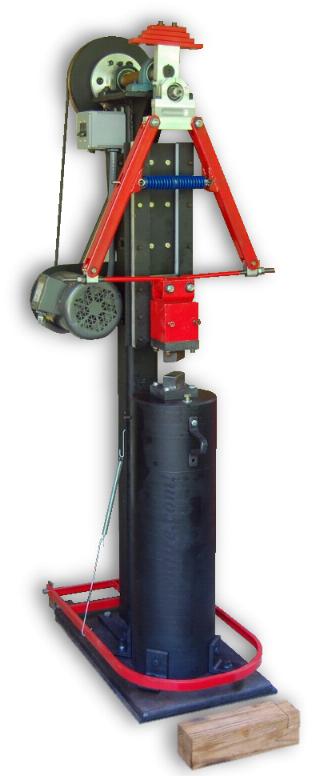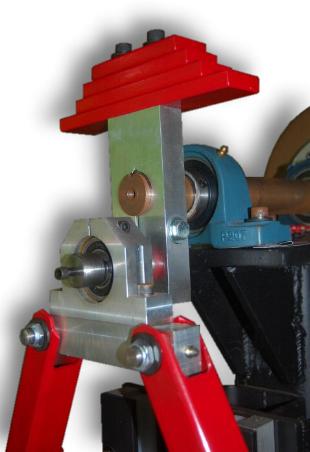 This hammer is based on the original DIY hammer built by Ray Clontz, before he came up with the Tire Hammer.
It uses a clutch mechanism built from two disk brake rotors with friction material in between.
Ray used a clutch disk, Fred used a sheet of friction material.
This hammer is based on the original DIY hammer built by Ray Clontz, before he came up with the Tire Hammer.
It uses a clutch mechanism built from two disk brake rotors with friction material in between.
Ray used a clutch disk, Fred used a sheet of friction material.
Fred builds Rose Engines or Holtzapffel type lathes.
These have a complex gearing system that moves the cutting tool to produce geometric patterns on the work being turned.
He applied his machining expertise to building this beautiful little hammer.
Practically all DIY and Junk Yard hammers have significant faults.
Our anvilfire X1 should have had the ram turned 90° to suit the frame design and the guides should have been longer.
The most significant fault on this hammer is the length of the link arms and toggles.
The long length results in a long "sloppy" action that hits very hard but will be difficult to control.
As of this writing Fred is running the hammer fairly slow, 2.6 hits per second or 156 RPM top speed and slower while slipping the clutch.
That is about half the speed we are running our 110 pound anvilfire X1.
Normally a light hammer like this would run 350 to 400 blows per minute.
However, this hammer with its light spring and long toggles would flail itself to death at those speeds.
Slower is better when building a DIY machine.
This hammer has a 660 pound anvil giving it a very high efficiency 18 : 1 Anvil to ram ratio.
 Crank Plate and Shafts
Crank Plate and Shafts
High strength aluminium alloy is a joy to machine and has similar strength to mild steel.
In this case the aluminium reduces some of the unbalanced reciprocal mass.
Instead of a relatively heavy iron pillow block for the pitman Fred made his own.
The red blocks at the top are counterweights to balance that side to side reciprocal mass.
This is half the mass of the link arms and pitman located at the pitman radius.
However, for smooth operation some flywheel effect does not hurt and extra mass here acts like a flywheel.
Fred has the crank arm both keyed and clamped to the shaft.
This is a good method to assure a tight fit that will not work loose.
 Clutch
Clutch
The clutch uses two disk brake rotors, one fixed to the shaft and one floating on bearings.
There is friction material between the two. Ray Clontz used an auto clutch disk (this is what I would do).
Pressure is required to engage the clutch (rather than disengage as in an automobile).
This is applied through a thrust bearing.
The floating disk has a V-belt groove machined at the ventilation line.
This is a very beautifully built machine and even though Fred used a lot of scrap parts it is far from being a Junk Yard Hammer.
While the rear mounted drive takes the hammer out of the realm of many DIY and JYH builders I have come to appreciate it more and more.
The current Tire Hammer design has a serious flaw in the welding of the pitman to the wheel.
They would benefit greatly by having the tire and wheel mounted on the back where it would be unmodified and easy to maintain.
Fred's Hammer page on his Ornamental Rose Engine website More details . .
Catalog of Junk Yard and DIY Hammers
| 

 This hammer is based on the original DIY hammer built by Ray Clontz, before he came up with the Tire Hammer.
It uses a clutch mechanism built from two disk brake rotors with friction material in between.
Ray used a clutch disk, Fred used a sheet of friction material.
This hammer is based on the original DIY hammer built by Ray Clontz, before he came up with the Tire Hammer.
It uses a clutch mechanism built from two disk brake rotors with friction material in between.
Ray used a clutch disk, Fred used a sheet of friction material.

Crank Plate and Shafts
High strength aluminium alloy is a joy to machine and has similar strength to mild steel. In this case the aluminium reduces some of the unbalanced reciprocal mass. Instead of a relatively heavy iron pillow block for the pitman Fred made his own.
The red blocks at the top are counterweights to balance that side to side reciprocal mass. This is half the mass of the link arms and pitman located at the pitman radius. However, for smooth operation some flywheel effect does not hurt and extra mass here acts like a flywheel.
Fred has the crank arm both keyed and clamped to the shaft. This is a good method to assure a tight fit that will not work loose.
 Clutch
Clutch
The clutch uses two disk brake rotors, one fixed to the shaft and one floating on bearings. There is friction material between the two. Ray Clontz used an auto clutch disk (this is what I would do).
Pressure is required to engage the clutch (rather than disengage as in an automobile). This is applied through a thrust bearing.
The floating disk has a V-belt groove machined at the ventilation line.
This is a very beautifully built machine and even though Fred used a lot of scrap parts it is far from being a Junk Yard Hammer.
While the rear mounted drive takes the hammer out of the realm of many DIY and JYH builders I have come to appreciate it more and more. The current Tire Hammer design has a serious flaw in the welding of the pitman to the wheel. They would benefit greatly by having the tire and wheel mounted on the back where it would be unmodified and easy to maintain.
Fred's Hammer page on his Ornamental Rose Engine website More details . .
Catalog of Junk Yard and DIY Hammers